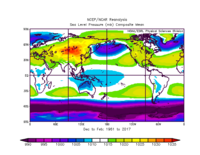Siberian High
| Siberian High | |
|---|---|
| Area of occurrence | Northeastern part of Eurasia |
| Season | September–April |
| Effect | Severe winter cold and attendant dry conditions with little snow and few or no glaciers |
TheSiberian High(alsoSiberian Anticyclone;Russian:Азиатский антициклон(Aziatsky antitsiklon);Chinese:Siberia cao áp;PinyinXībólìyǎ gāoyā) is a massive collection of cold dry air that accumulates in the northeastern part ofEurasiafrom September until April. It is usually centered onLake Baikal.[1]It reaches its greatest size and strength in thewinterwhen the air temperature near the center of thehigh-pressure areais often lower than −40°C(−40°F). Theatmospheric pressureis often above 1,040millibars(31inHg). The Siberian High is the strongest semi-permanent high in the northern hemisphere and is responsible for both the lowest temperature in the Northern Hemisphere outsideGreenland,of −67.8 °C (−90.0 °F) on 15 January 1885 atVerkhoyansk,and the highest pressure, 1083.8mbar(108.38kPa,32.01inHg) atAgata,Krasnoyarsk Krai,on 31 December 1968, ever recorded.[2]The Siberian High is responsible both forsevere winter coldand attendant dry conditions with little snow and few or no glaciers acrossAsian part of Russia,Mongolia,andChina.During thesummer,the Siberian High is largely replaced by theAsiatic low.
Overview[edit]

The Siberian High affects the weather patterns in most parts of theNorthern Hemisphere:its influence extends as far west asItaly,[3]bringing freezing conditions also in the warm South,[4]and as far southeast asMalaysia,[5]where it is a critical component of the northeastmonsoon.Occasionally a strong Siberian High can bring unusually cold weather into the tropics as far southeast as thePhilippines.[6]It may block or reduce the size oflow-pressure cellsand generate dry weather across much of the Asian landscape with the exception of regions such asHokurikuand theCaspian Seacoast ofIranthat receiveorographicrainfall from the winds it generates. As a result of the Siberian High, coastal winters in the main city of Pacific RussiaVladivostokare very cold in relation to its latitude and proximity to the ocean.
Siberian air is generally colder than Arctic air, because unlike Arctic air which forms over thesea icearound theNorth Pole,Siberian air forms over the cold tundra of Siberia, which does not radiate heat the same way the ice of the Arctic does.[7]
Genesis and variability[edit]
In general, the Siberian High-pressure system begins to build up at the end of August, reaches its peak in the winter, and remains strong until the end of April. Its genesis at the end of the Arctic summer is caused by the convergence of summer air flows being cooled over interiornortheast Asiaas days shorten. In the process of the Siberian High's formation, the upper-level jet is transferred across northern Eurasia by adiabatic cooling and descendingadvection,which in extreme cases creates "cold domes"that outbreak over warmer parts ofEast Asia.
In spite of its immense influence on the weather experienced by a large proportion of the world's population, scientific studies of the Siberian High have been late in coming, though variability of its behavior was observed as early as the 1960s.[1]However, recent studies of observedglobal warmingoverAsiahave shown that weakening of the Siberian High is a prime driver of warmer winters in almost all of inland extra-tropical Asia and even over most parts ofEurope,[1]with the strongest relationship over theWest Siberian Plainand significant relationships as far west asHungaryand as far southeast asGuangdong.Precipitationhas also been found to be similarly inversely related to the mean central pressure of the Siberian High over almost all ofEastern Europeduring theborealwinter, and similar relationships are found in southern China, whilst the opposite correlation exists over theCoromandel CoastandSri Lanka.Other studies have suggested that the strength of the Siberian High shows an inverse correlation with the high-pressure systems over North Africa. Another correlation has been noted, a connection of a weaker Siberian High andArctic oscillationwhen theAntarctic oscillation(AAO) is stronger.[8]
Because increased snow and ice cover enhances the Siberian High,[9]the Siberian High was both more intense and located further west during the earlyMiddle Pleistoceneas a result of the extensive glaciation ofmountain rangesacross Central Asia.[10]The decrease in magnitude of the Siberian High during the Holocene enabled eastward encroachment of westerlies enriched withwater vapour,precipitating an increase in low altitude afforestation of Central Asia.[11]
See also[edit]
References[edit]
- ^abc“The Siberian High and Climate Change over Middle to High-Latitude Asia”Archived26 April 2012 at theWayback Machine
- ^Encyclopedia of world climatologyby John E. Oliver, 2005,ISBN1-402-03264-1
- ^D'Arrigo, Rosanne;Jacoby, Gordon; Wilson, Rob; Panagiotopoulos, Fotis (2005)."A reconstructed Siberian High index since A.D. 1599 from Eurasian and North American tree rings"(PDF).Geophysical Research Letters.32(5).Bibcode:2005GeoRL..32.5705D.doi:10.1029/2004GL022271.
- ^"Icy wind from Siberia will bring winter back to Italy - The Local".Archived fromthe originalon 21 February 2018.
- ^Chang Chih-peh,The East Asian Monsoon;p. 55.ISBN978-9-812-38769-1
- ^""Record Chill Spreads Deep into Southeast Asia"".Archived fromthe originalon 30 July 2021.Retrieved11 December2011.
- ^"Siberian anticyclone | meteorology".
- ^Fan, Ke (2004)."Antarctic oscillation and the dust weather frequency in North China"(PDF).Geophysical Research Letters.31(10): n/a.Bibcode:2004GeoRL..3110201F.doi:10.1029/2004GL019465.hdl:10289/1741.
- ^Cohen, Judah; Saito, Kazuyuki; Entekhabi, Dara (January 2001)."The role of Siberian High in Northern Hemisphere climate variability".Geophysical Research Letters.28(2): 299–302.Bibcode:2001GeoRL..28..299C.doi:10.1029/2000GL011927.hdl:1721.1/110326.S2CID129024923.Retrieved4 November2022.
- ^Bradák, B.; Újvári, G.; Stevens, T.; Bógalo, M. F.; González, M. I.; Hyodo, M.; Gomez, C. (1 January 2022)."Potential drivers of disparity in early Middle Pleistocene interglacial climate response over Eurasia".Palaeogeography, Palaeoclimatology, Palaeoecology.585:110719.Bibcode:2022PPP...58510719B.doi:10.1016/j.palaeo.2021.110719.S2CID239066555.
- ^Zhang, Dongliang; Chen, Xi; Li, Yaoming; Zhang, Shengrui (15 July 2020)."Holocene vegetation dynamics and associated climate changes in the Altai Mountains of the Arid Central Asia".Palaeogeography, Palaeoclimatology, Palaeoecology.550:109744.Bibcode:2020PPP...55009744Z.doi:10.1016/j.palaeo.2020.109744.S2CID216474621.Retrieved5 November2022.

